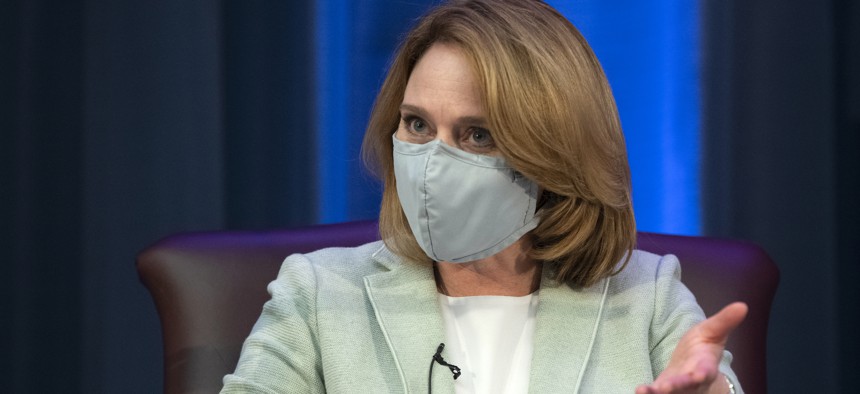
Deputy Secretary of Defense Kathleen H. Hicks participates in a Business Executives for National Security industry discussion on April 11, 2022. DOD / Lisa Ferdinando
Biden Already Willing to Increase Recent Defense Spending Request
Just six weeks after requesting $773 billion for 2023, the Pentagon’s No. 2 acknowledges the military may need more money, due to inflation.
The Biden administration is willing to increase the president’s defense spending request sent to Congress just six weeks ago to mitigate inflation’s impacts on the military, said the Pentagon’s No. 2 civilian leader.
Deputy Defense Secretary Kathleen Hicks’ remarks come amid intense criticism from Republicans who have already pressed the president, senior administration, and military leaders to increase the defense budget to meet the rising costs of the Russia-Ukraine conflict and compete with China’s military buildup.
“We are concerned that the Department is not taking a proactive stance to mitigate the harmful effects of inflation,” Sen. Jim Inhofe, R-Okla., and Rep. Mike Rogers, R-Ala., the ranking members of the Senate and House Armed Services Committees said in a statement this week. “It doesn’t seem that the department has a good grasp on how inflation is hurting our service members and their families—and how this is in turn impacting recruiting and retention.”
The Defense Department requested $773 billion for fiscal 2023, an 8 percent increase over the administration’s request for the previous year and 4 percent more than Congress approved for the military in the 2022 omnibus. But with inflation reaching as high as 8.5 percent in March, and uncertainty about the economy’s future, lawmakers are worried how far that money will go.
Hicks said the Pentagon is ready and willing to work with Congress on an updated budget number that reflects the most accurate inflation estimates.
“We don’t know what that inflation number will be,” Hicks said in an interview Friday with Roger Zakheim, director of the Ronald Reagan Institute and former Republican senior staff member of the House Armed Services Committee. “The inflation number we used last fall…is always just a forecast. Where inflation will be in September, let alone this time next year, we don’t know, but we want to work with Congress on the ‘23 budget to make sure we have the purchasing power for this program.”
Despite the Pentagon’s and Congress’ best estimates, Biden administration leaders may ask Congress for more money in supplemental budget requests next year if inflation costs soar more than anticipated, she said.
“If at the end of the day, it’s this program with an inflation factor that is again going to be a projection by the United States Congress that we all feel is closer to accurate, and then we work on through supplementals next year anything where we’re off…I think that’s a really good outcome for us,” she said.
Inflation typically hits defense harder than other economic sectors, according to a McKinsey & Company report in March. Currently, the Pentagon’s budget is expected to increase to $810 billion by 2026, excluding military construction. If the inflation rate stays at 7 percent annually and the budget isn’t increased to reflect the rising costs, that would decrease the Defense Department’s purchasing power—the money it spends on new weapons, equipment, suppliers, and other items—to $578 billion in 2026, according to the report. The cumulative lost buying power between 2021 and 2026 could be about $480 billion, or the equivalent of about 6,000 F-35 fighter jets.
Hicks urged Congress to pass a budget ahead of the fiscal year that begins Oct. 1, saying that passing the department’s higher budget request is better than locking in spending at the 2022 level, especially with inflation on the rise. Lawmakers in recent years have often debated the annual defense spending authorization bill well into the fall or winter, months past the fiscal deadline, by funding the federal government via a series of continuing resolutions, or CRs.
“The best inflation buster we have is on-time appropriations,” she said. “That 4 percent is 4 percent more than we would get if we stay on a CR, and I think we all know we’re going to be on a CR.”





